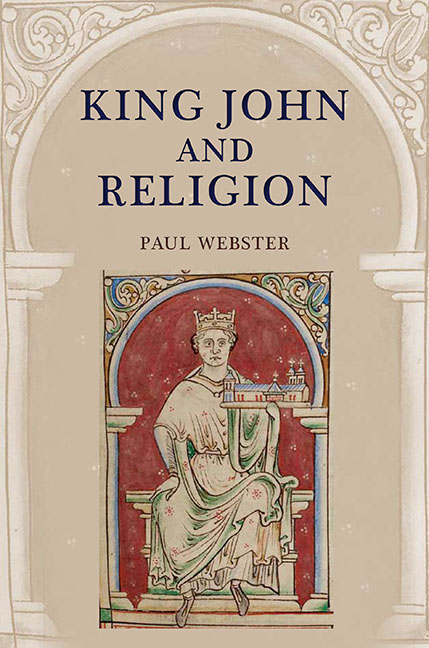Book contents
- Frontmatter
- Dedication
- Contents
- List of Illustrations
- Acknowledgements
- Abbreviations
- Introduction
- 1 The Mass
- 2 The Saints
- 3 Powerhouses of Prayer
- 4 Family
- 5 Charity and Almsgiving
- 6 Religion, Politics, and Reputation: The Interdict and King John’s Excommunication
- 7 Peace with the Pope: Diplomacy, Personal Religion, and Civil War
- 8 King John’s Deathbed and Beyond
- Conclusion
- Bibliography
- Index
- Other volumes in Studies in the History of Medieval Religion
- Frontmatter
- Dedication
- Contents
- List of Illustrations
- Acknowledgements
- Abbreviations
- Introduction
- 1 The Mass
- 2 The Saints
- 3 Powerhouses of Prayer
- 4 Family
- 5 Charity and Almsgiving
- 6 Religion, Politics, and Reputation: The Interdict and King John’s Excommunication
- 7 Peace with the Pope: Diplomacy, Personal Religion, and Civil War
- 8 King John’s Deathbed and Beyond
- Conclusion
- Bibliography
- Index
- Other volumes in Studies in the History of Medieval Religion
Summary
John's attendance at religious services provides a starting point in the search for evidence of his personal religion. In particular, to what extent did he engage with the ritual of the mass? This rite was of central importance to medieval men and women, albeit that it attracted ‘a broad spectrum of responses … from the extravagant, intense and devout on one end, to the distracted, apathetic, dismissive or hostile on the other’. The schoolmen of the day tied themselves in complex intellectual knots debating the transformation that took place in the consecrated host. Yet on the more practical level of the ordinary churchgoer it is often hard to determine how often they were in attendance. It was only if something out of the ordinary occurred that those present (or absent) attracted the attention of medieval commentators, themselves often men of religion for whom the mass was an accepted part of daily routine. This chapter considers the king's engagement with two different types of mass. Firstly, those for the living community of the faithful, which John is likely to have attended in person and, in the context of the royal household, for which he sometimes provided in terms of paraphernalia and personnel. Here, it should be noted at the outset that we are not necessarily looking for evidence of his having taken communion. The Fourth Lateran Council (1215) laid down that this should occur only three times a year, at Whitsun, Easter, and Christmas, with Easter as an acceptable minimum requirement. Rather, increasing focus on the wondrous nature of the Eucharist – the presence in the priest's hands of the body and blood of Christ – led to an emphasis on the value of seeing the ceremony take place. Thus, it is valuable to seek evidence of occasions when John is known to have been present on an occasion when mass was celebrated, and to consider what steps he took to ensure that it could take place within his household. Secondly, discussion focuses on masses commissioned by John, to be performed on his behalf but in his absence, for his wellbeing whilst alive, and for his soul after his death.
- Type
- Chapter
- Information
- King John and Religion , pp. 19 - 36Publisher: Boydell & BrewerPrint publication year: 2015

